Robert Moynier Paipo
Interview
July 5, 2010. Cambria, California, USA
Questions and e-mail interview by Bob Green
Photos courtesy of Robert Moynier
1. You briefly described your first board in the kurungabaa blog.1 Can you give a few more details?
It
was primarily a skim board but had multi usages. Belly boarding was
definitely one of them. Got the board as a birthday present on my 8th
birthday, in January 1959. My father made it for me and it became a
part of my "quiver" of foamies, and surf mats. We were living right
across from the Lifesaving Club/pools at South Curl Curl at the time
and I was in the water pretty much every day. I'm going off a long
memory here, but I believe it was no longer than 3'6", about 22” wide,
and probably three-quarter inch plywood. It was a rectangle, and my Dad rounded the
nose to a half moon with a hand saw. He soaked the board overnight in
water and the next day and set it in the sun on a platform of bricks at
either end, and put a few on top about 9" from the nose to bend it
somewhat. The result was when it dried out it had a good bit of nose
rocker. I don't remember whose idea that was, but it probably was
specific to our beach as we had a pretty good drop off from the shore
to the shore break, and when skimming down it to smash into the lip or
whitewater, that rocker really helped! The rails were sanded at an
upward tilt to the deck, and it got about 3 coats of marine varnish to
finish it up.
|
The Peace Model in 1976. This was a kneeboard template, 6'4' regular Bonzer, shaped by Malcolm Campbell.
.
|
2. How long did you use this board -- were there other bellyboarders around?
I
used it for about 2 to 3 years, probably 50-50 as a skimboard and belly
board. For the belly board action it was primarily jump into a shore
break wave, or swim out to the sand bar and kick in kind of thing, (we
used swim fins for that). Main spot of course was South Curl Curl, but
also a lot at Freshwater (Harbord) beach, and a bit at North Curl Curl.
It seems to me that most of the kids were doing the same thing, namely
switching off skimming and belly boarding depending on conditions...
plywood was the most common material for the boards, but as I mentioned
I also rode foamies and mats and they were very common. As a kid at
that time, it was very much a given that as you got older and stronger
you would naturally progress to a "real" surfboard, namely a stand-up
board, and then you could really go "surfing" and be a "surfer". Ha!
3. So when did you get a “real surfboard?”
Well,
my family moved to the U.S. in mid-1962, to Ojai, California, not far from
Ventura and all those nice point breaks (C Street, Pitas, Rincon) and
so I carried on surfing and got my first stand-up board late-1962, or so.
Not only was it a real surfboard (9'6'), but it was also a real piece
of crap, funky template, deck delaminating, tons of dings etc., but I
think it cost $20 so not such a bad deal. And, as far as paipos, I
stuck with it for another year or so, made a couple and took them,
along with my stand-up board on our surf trips. These were definitely
paipos at this stage, same dimensions as my first one, but I added a
couple little plywood keel fins (screwed in from the top as a wood shop
class project) and rode them at some nice spots including Pitas,
Ventura, and the various beach breaks north of Ventura like the
Overhead and Solimar, etc. Still, by the end of 1963, my paipo days
were pretty much over, and I became solely a stand-up surfer until the
late 1960s, when guys like Greenough and others started reminding
people there was more to life than just standing tall on a wave.
4. Between the early- to late-Sixties, were you seeing any bellyboarders about?
Actually
I did, and the reason for that was my family moved down to the Newport
Beach/Orange County area and I ended up surfing Newport/Huntington
beach heavily between 1966 through the summer of 1970. If there was
ever anything resembling a center of paipo/bellyboarding culture in the
continental U.S. it was probably that area. The most important
functional reason for this was the existence of the "black ball" surf
access restrictions that took place every summer in Newport and
Huntington. What this meant was whenever the black ball flags were up,
usually from 9am to 5pm, June through September, nobody could be out in
the water riding anything longer than 5-foot, or you'd get called in,
cited, and charged with a hefty little fine. Basically they were trying
to make the beach and ocean tourist friendly and reduce collisions and
injuries between the vacationers and out of control longboarders. Or
perhaps it was the other way around. In any case, it worked pretty well
and fortunately it had the unintended consequence of spawning a real
area subculture and mini industry of paipo riders, mat surfers,
bodysurfers, and even some kneeboarders. Both Newport and Huntington
get pretty good during summer south and southwest swells, so with the
seasonal elimination of the longboard, it was an ideal environment for
the alternative surfcraft people to do their thing relatively hassle
free and really hone their skills in some challenging, quality spots
like the Wedge, Newport Point, and Huntington Pier. To take care of
these surfers, you had a number of business, like Newport Paipo and
Jack's Surfboards, focusing in on making a fair amount of bellyboards
and kneeboards, and other people working on improving swim fins, making
hand boards, etc. So all the stuff that was otherwise taking place in
isolated pockets up and down the coast was happening in this one,
small, concentrated area.
5. What kind of boards were you riding at that time?
I
was riding the typical longboards of the era. The boards ranged
anywhere from 8'10" to 10' in length. Some good quality boards such as
Surfboards Hawaii, Bing, Jacobs, etc. Then of course, all hell broke
loose in 1968, and the combination of the Australian/Greenough
influence on shorter more manoeuvrable boards, and the stuff that was
coming out of Hawaii via Dick Brewer and others (mini guns, pocket
rockets) was an irresistible force. So, it's a well known story that
board lengths dropped 2 to 3 feet within a year and there was a real
interest, fuelled by media, about Greenough and what exactly was that
thing he was riding and how did he do what he did. This in turn led
me, and many others, to look at his templates, his theories on fins, on
flex, and reduced length to see if that would work either in a stand-up
mode, or a combination knee-stand-up approach.
Since
I was in Newport, and was already stand-up riding foamies in the black
ball times, it wasn't necessarily a huge stretch for me lengthwise,
but there weren't any surfboards per se that were in the 5’0” to 5'6"
range, which is where I wanted to go. Therefore, I was wrapped up in
riding kneeboards standing-up, and taking these $5 Styrofoam boards,
reinforcing them with curtain rods for stringers, and glassing them.
They actually worked pretty well in punchy beach break type waves and
I took a couple with me to Oahu and Maui, in 1970, with mixed results.
These boards were good at places like Sandy Beach, and even (very) small
Pipe, but not so good at pole set Ala Moana! Concurrently, I had torn
down a 6'10" Nat Young Weber Ski and reshaped it to become a 5'6”
displacement hull (although I didn't know it was that at the time) and
that one worked quite well.
Anyway,
by late 1970, I was riding a 5'6" Newport Paipo "Shoe," a dished out,
very hard railed and very fast stand-up/kneeboard combo. From there
Walden Surfboards made me a 5-foot dished-out deck, soft-railed board
that was brilliant in most surf up to about 6 foot. That was a board I
kept and rode until the late-1970s. Around 1972, I met the Campbell
Brothers in Oxnard, and glassed in some “Bonzer” runners on the thing,
and it rode even better! Duncan still has some footage of me on it from
1972, somewhere in the archives. In all of this what was happening, at
least for me, was trying to find that combination of length, template,
and volume that would allow a stand-up surfer to draw those kneeboard
lines. Looking for that nexus between the paipo/kneeboard experience
and a functional stand-up surfboard, I found that was possible
utilizing the Bonzer bottom and fin configurations, and for the most
part, have been riding Campbell Bros. Bonzers in a variety of lengths
and templates ever since.
Robert Moynier "covering some distance over the flats on the 5'7" (Cambria in 1977-1978).
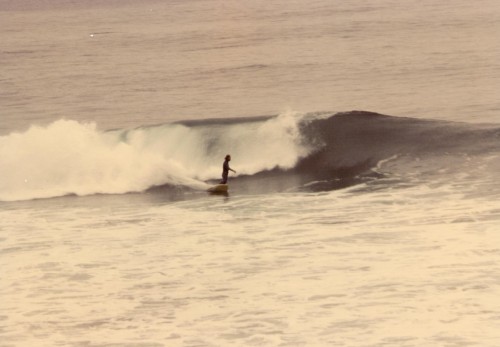
Robert
holding 'Spike' and the 5'7" Bonzer that he shaped. The Bonzer runner
fins were added later.
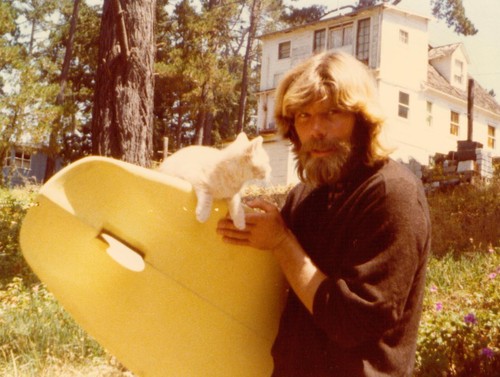
6.
You have posted on another blog2 about a paipo built by Gordon
Thietz and ridden by Candy Calhoun.3 Can you tell me about your
more recent experience riding prone? How did you get started riding
prone again and what are you riding?
What
got me into it was a flurry of injuries about 2 years ago involving
Achilles tendons, sprained ankles, and a broken big toe. These kinds of
things tend to put a damper on stand-up surfing, so it was natural to
re-focus on riding prone in order to keep in the ocean as part of my
rehab. I had never actually left that aspect of surfing, but it was
something I only did maybe a half dozen times a year, on my stand-up
board, usually in small, lined-up conditions. I always was stoked at
the sensation of speed and immediacy to the wave and water, plus the
fact that when prone, it's always overhead! So recently I started
surfing consistently prone due to physical factors, but as I healed up,
I have not found myself necessarily craving a return to the stand-up
experience. I've actually become more intrigued with the different
aspects of trim, drift, body torque, speed, and wave "touch" that prone
allows. I am riding my stand-up boards doing this, on 7'8'', 8'0" and
9'0' boards, all Bonzers.
Pictured
below are Robert's 8'0" regular 3-fin bonzer, the 9'0" 5-fin bonzer
(described as "a ridiculously manoueverable longboard and sometimes
scary fast!") and his 7'8' bonzer with 5 fins.
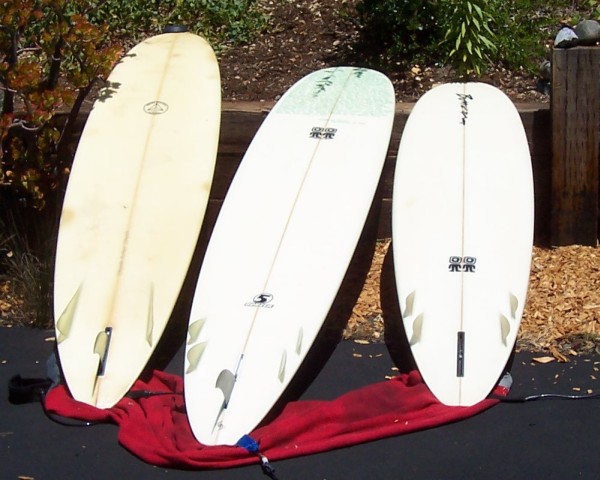
There
are a couple things right now that stand out: one is the impression I'm
getting of being able to hold a very high trim line for what seems an
extended period of time and a resultant heavy sensation of speed. These
are pretty long boards for prone stuff, and it's rare for me to be
surfing from the tail lying down. Typically when trimming up, I'm on
the front third of the board with all my body weight pressing down,
outside arm pulling the rail up or, in full flight, both hands on the
deck and body in push up position. It seems to me this combination of
weight distribution, and the fact that you're actually surfing from the
area of the board (the front third), that normally gives you the most
speed, is possibly allowing you to maximize the trim/speed potential of
the board in way not possible standing-up.
I
really got that feeling the other day surfing the 9'0” at a local sand
bar break that upon occasion thinks it is a point. Small (2 to 4 foot) waves,
but clean, and I was able to experiment with in essence rather long
floaters that would let you pass through many sections on the way to a
little barrel. Stoked! The other aspect happening now is body torque.
The longer boards require a bit of muscling around sometimes,
particularly in the stop and go beach breaks I normally ride. This
takes the form of serious hand, and leg dragging to slow it all down,
and/or set up the sideslip drift, which is in essence the same thing.
Also, I've noticed on critical take-offs, my body is frequently off the
board as I'm putting all my force to the inside rail and basically just
following the board itself around until a rail or fin connects and then
off you go.
Robert’s 9’0 board.

The
downside to these longboards for prone is the inability to either punch
through the back of a close-out section (we get a lot of those around
here), or break a tight trim in the same situation, which can lead to
some nasty head clips from the lip, and digging the outside rail, or
both.
I
am sure these sensations are universal for body boarders of all types.
I've experienced it myself before. But the difference for me at this
point is the potential opening up in riding these longer boards…it's
like a new language is being created, or perhaps landing on an unknown
planet. Don't exactly know what’s going to happen, but it's sure got my
attention!
One
additional aspect of this is other surfers reactions… it is really
interesting, and seems to follow two main categories. The first appears
to be a genuine concern for my physical and or psychological well
being. The question here is usually "hey man, are you ok? I mean, your
leg must be pretty bad for you to be riding on your stomach all the
time...", or more to the point, just a simple "Hey man, are you ok?”
implying that there is no reasonable explanation possible to justify
what I'm doing. And the other (my favorite) basically involves a denial
of the form itself, as in "Hey, are you ever gonna surf again, or you
just gonna ride on your stomach?" I had to laugh when I saw the Paul
Gross interview and he mentioned a couple guys who are also riding
prone on stand-up boards and he said one of the guy’s friends wanted to
do an intervention… presumably to bring him back into the fold before
he ruined his life forever! That is not far off in my experience
either. But what it really does is point out the power of the
conditioning process that most surfers absorb, and never question, that
defines surfing and surf vehicles as being part of some sort of
neo-Darwinist continuum beginning with bodysurfing/belly boarding as a
basic primeval ooze state and progressing through more complex forms of
riding (kneeboards), to the pinnacle of it all, the stand-up surfboard
and stand-up surfing as Homo-Erectus! So clearly, this kind of surfing
approach doesn't lend itself to mass appeal for all kinds of reasons,
but that's really not news, or important to me… that's not why I surf
and never has been. I am stoked and grateful to be in the water, even
more so to have this prone riding thread to follow, and if I can bring
some of that stoke and open attitude back with me to the land, then I'm
calling it both a good ride, a good day, and a very good thing.
Robert’s 9’0 board – the green text is a poem he wrote.

Below
is a close-up of the poem which ends with a quote from Allen Ginsburg,
via the Book of Psalms: "Wisdom of Serpent... Harmlessness of Dove."
Robert wrote, "I put it on the bottom of my board... helps me remember
why I surf and every once in a while somebody asks me what the hell all
those words mean. Opens up some real dialogue."
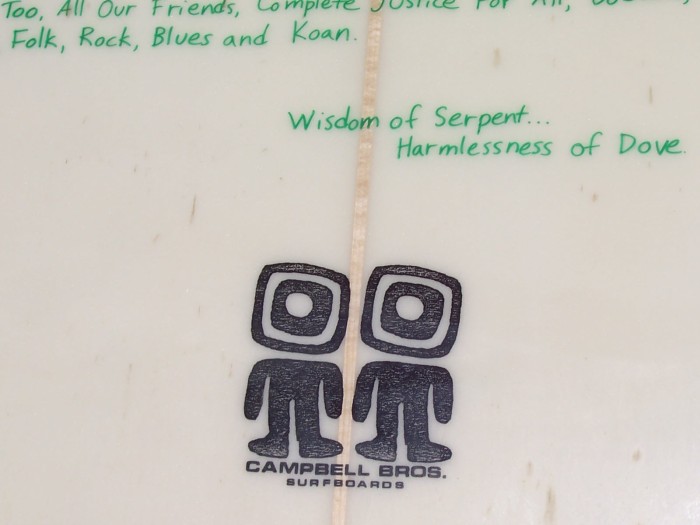
7. Any other comments?
It's
an interesting time in surfing. It seems the culture has given itself
permission to re-examine some of its most basic tenets in terms of what
constitutes "surfing" and what vehicle, if any, is the way to ride a
given wave. So it's now acceptable not only to deviate from the lock
step of the thruster-centric ASP domination of the surfing media and
market place, it's almost a required attitude. What this effectively
means is the average rider now sees it as a desirable thing to have a
varied quiver of wave riding tools, each one fitting a certain
situation. This quiver includes everything from longboards to retro
logs, to hulls, fishes, velos (spoons), alaias, single fins, no fins,
Bonzers, mini-Sims, wood boards, flex tails, hand planes, body surfing,
and yes (possibly maybe), even paipos, to name just a few options.
How
this will shake out over the next few years is anyone's guess. The
marketing people are already busy commodifying this trend by promoting
the image of the eclectic, wandering, surfer hipster… part gypsy, part
surfer, part musician/artist, part shaper, etc., just out there loving
his simple, organic life, as the current model to emulate. And after
all, that's not such a bad thing; the seeds are there for a much more
personal and inclusive approach to the surfing experience, as they
always have been, but historically it's been an against the grain,
non-commercial movement, so we'll see how this turns out as the
attitude of open innovation (allegedly) becomes mainstream.
My
direct history with paipo, as you can see, has been relatively limited…
however, along with my first surf experiences of bodysurfing, really
set up a life long surfing attitude. A big part of that is the feeling
of being IN the water -- not on top of it -- and how enjoyable that is.
Being immersed in the water with the paipo… basically swimming, your
perception of space… the area of the surf zone, the take-off, ride and
perception of the wave itself is much more immediate and (primal) than
say, a stand-up board, or even a kneeboard. That feeling of being part
of the water, the currents, tidal pull and wave power is one of the
most beneficial things about any surfing activity and I think, why
paipo for example, will never disappear as a functional art. It's
really a deep ecology experience and one that surfers are privileged to
enjoy every time they hit the water.
Recently
on the Hydrodynamica blog,4 Reno Abellira was caught ranting away about
the need for surfers to wake up and experiment with all forms of design
and approaches to wave riding. He cited the 1970s a lot and drew some
parallels between then and now. On the desire for smaller more
responsive craft, he said, "So once again, back to the days of paipo,
shorter, faster lighter."
Makes sense to me.
Footnote 1. See the blog posting, "Surfoplanes by Peter Bowes," by Clifton Evers, July 22, 2009, on the Internet at: http://kurungabaa.net/2009/07/22/surfoplanes-by-peter-bowes/.
Footnote 2. See below an updated version of the blog posting, "Craft," by Dr. Robert Moynier, May 4, 2008, on the Internet at: http://thecentralshaft.blogspot.com/2008/05/craft.html.
Footnote 3. Candy
Calhoun is reported to be the first woman to bodysurf Pipeline and
Newport Wedge and she placed in stand-up competitions from 1962 through
1965 (Makaha, U.S. West Coast and Peru) (see Warshaw, Matt. (2003). The encyclopedia of
surfing. Orlando, Fla: Harcourt. She is listed as featuring in the films Locked In! (1964) and Stop the Wave, I Want to Get Off (1965) (see The Internet Movie Database). Candy was also reported to be a contributing editor to Surf Guide magazine (see Feigel, Robert R. (2004) "Death of a surf mag," Surfwriter, on the Internet at: http://www.surfwriter.net/deathofasurfmag.htm.
Footnote 4. See the blog posting "Reno Would Know," (2010, April 14). Hydrodynamica Rough Cuts (video), Reno Abellira 4/11/2010. Hydrodynamica, on the Internet at: http://hydrodynamica.blogspot.com/search?q=Reno.
Craft
Story by Dr, Robert Moynier
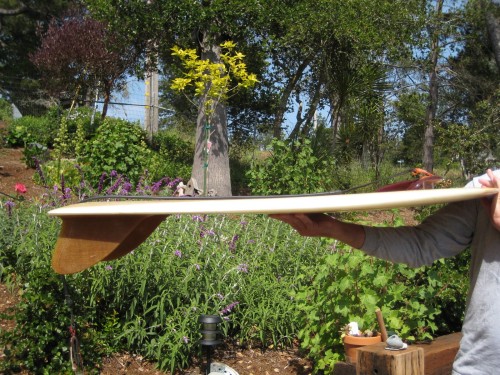
|
With all the interest in Simmons hydrodynamics, hulls, and alternative
surf vehicles of any and all stripes, I thought to throw this in the
mix.
|
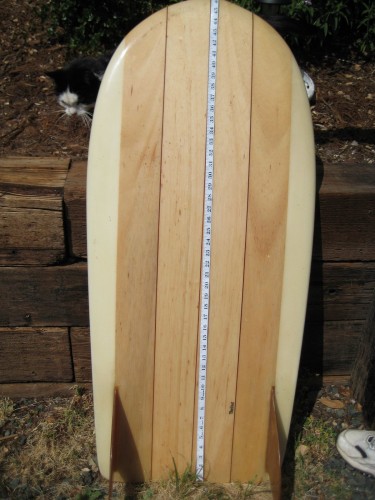
|
What you see here is a hydrodynamically sophisticated, potentially
lethal (in the right hands), planning foil of ancient origin..
created.. from glue up ( foam, balsa, redwood), shape, and
glassing...by Gordon Theisz.
|

|
This is one of a handful shaped by Gordon in the 70's thru mid 80's for
himself and his surfing partner and test pilot extraordinaire.. Candy
Calhoun. They both lived in the same Central Coast town as me.. and I
first became aware of them early 70's ..usually surfing obscure.. niche
spots, by themselves.. and was immediately blown away by the.. speed
that these guys got on any size wave. Gordon was a shaper from way back
for Wardy Surfboards...and Candy’s surfing pedigree.. and exploits have
been documented elsewhere. Sufficient to say, she has an intense..
highly focussed personality.. and would go through cycles of full blown
commitment to her surfing, followed by periods of years where other
interests would take over.. and surfing didn't exist.
She disappeared from local waters mid 70's..and re-appeared about 1980
with a real vengeance. That’s when my wife and I became her surfing
partners for the next year or so.. and we were able to witness up close
and personal an absolute one of a kind surfing approach and mastery. |
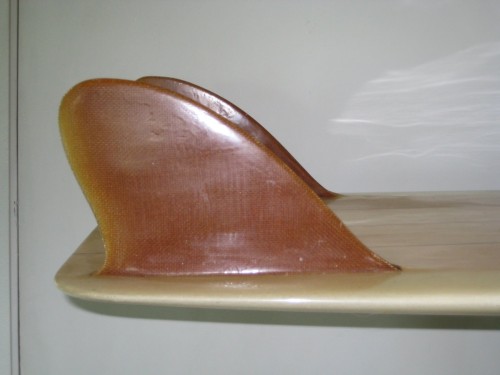
|
If a criteria for" good surfing' is speed, tight manoeuvres in the
curl, and barrel riding...then I can say that in 1980-81...I considered
Calhoun to be one of the best in the world
To this day.. with the exception of kite boarders and tow assisted
stand-up...I have never seen anyone go so damn fast, ride deeper, or
throw the most ridiculous, surreal, roundhouse cutbacks...board in
front, body following and holding on only to the redwood handle. On top
of that, she would go out in the most extreme conditions and more than
once shamed me with her lack of fear and or common sense. God knows
what she would have done at a good point break like say..6-8ft Malibu
or Burleigh.... |
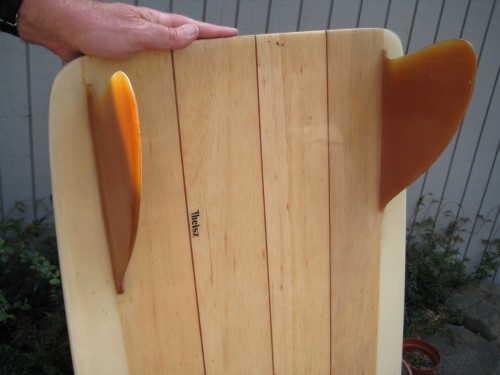
|
In any case, this particular board was made in 1980..she didn't care
for it much as it was a bit shorter than her normal craft and so it
came to us. Her boards were normally about 4'6"..and this one is just
under 4'...the dims' on this are: 48" length, 21" wide, 18" tail block,
1/2 to 1 1/4" thick , with the fins having a 9'' base and a 5 1/2'
height from trailing edge to deck bottom... the handle is varnished redwood.
There ya' go...a unique and timelessly functional craft designed for a singular personality...
glad I was able to see it in action.
Peace.
|
See Part II of the Robert Moynier paipo interviews with Malcolm Campbell.
|
|
|